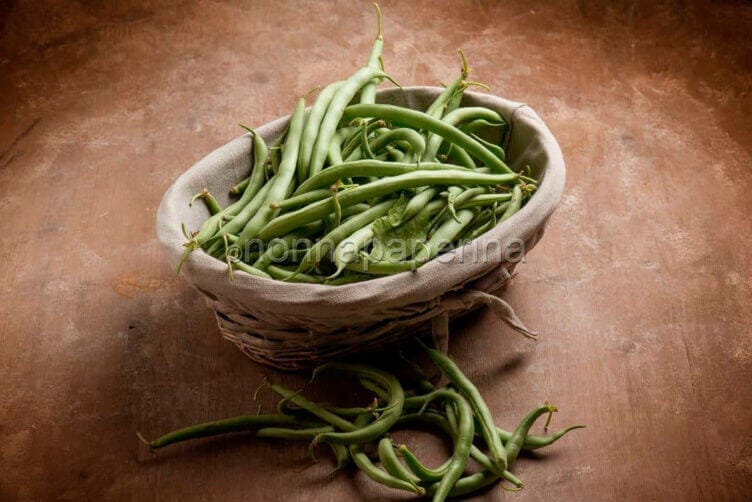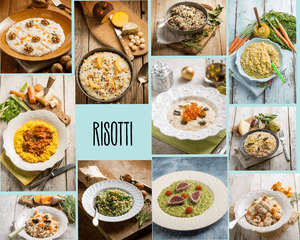Green beans

Legumes with an excellent concentration of fibre
It may seem strange, but green beans and classic beans are members of the same species, the “common bean,” scientifically called “Phaseolus Vulgaris.” Simply put, green beans are nothing more than the pods on the plant before the seeds inside them have fully ripened. The pods themselves are easier to digest because of this timing, among other reasons.
Correctly speaking, one notable quality of green beans is their relatively high nutritional value. Its concentration of fibre is higher than the average of other legumes. Added to this is a significant quantity of mineral salts, specifically potassium, calcium, magnesium, and silicon. In addition, green beans are rich in antioxidants, especially lutein, which is beneficial to your skin, eyes, and heart. High amounts of folic acid, also referred to as vitamin B9, are present in terms of vitamins. Finally, their caloric intake is very low, equal to only 25 kcal per 100 grammes.
The main varieties of green beans
- Green: This is the most common and widely available variety. They are dark green in colour and have a sweet, crunchy lavor. They are used in a wide range of dishes and preparations.
- Yellow: This variety has a bright yellow color. They taste similar to the green ones and can add a different pop of colour to your dishes.
- Purple: They have a bright colour and can vary from deep purple to lighter purple. This variety also adds an interesting visual element to dishes.
- Roman: This variety is also known as “flat green beans” or “Roman green beans.” They are flat, wide, and tender, with a slightly sweet flavour.
- Italian: These are also known as “extra thin green beans” or “Haricots Verts”. They are thinner and more tender than regular green beans and they are often used in French cuisine.
- Spanish: This variety is thicker and fleshier than standard ones. They are often used in dishes such as the Spanish paella.
- Long: These green beans are known for their length and thinness. They are ideal for elegant dishes.
In addition to these varieties, there are many other regional and local variations of green beans around the world. Each variety has its own flavour and characteristics and lends itself to different culinary preparations. The sort of meal you wish to make and the final dish’s desired visual impression can frequently influence your choice of variety. the anthocyanin dante.
What advantages do green beans offer?
As we have seen, they boast a good nutritional profile. It is not surprising, therefore, that the impact on health is very good and that it results in some concrete benefits associated with all the varieties: green, purple, yellow beans, etc. But let’s examine them in more detail and discover their advantages.
They aid in digestion. They are rich in fibre; hence, they stimulate the activity of the digestive system and resolve episodes of mild constipation.
They promote growth. They are perfect for children as they are rich in group B vitamins, which support the growth path. The reference is to the important vitamin B9, also known as folic acid.
They keep blood sugar and bad cholesterol at bay. Bad cholesterol and blood “sugar” levels are also impacted by the nutritional structure. This is an important detail considering the prevalence of diabetes and the dangers associated with elevated cholesterol.
They cleanse. Because they contain certain compounds and a large amount of water, they efficiently fight water retention and detoxify the body.
Do they have any contraindications? It seems strange to ask this question given the many benefits they bring. In reality, the contraindications are almost absent and, at most, caused by excessive consumption. It alludes to the high content of fibre in green beans, which can be a double-edged sword. Specifically, it can have a laxative effect and create digestive issues.
Are green beans a resource for those who want to lose weight?
In addition to being low in calories, they offer a series of advantages that make them an excellent resource for those who want to lose weight. Their low caloric density is certainly a plus when it comes to maintaining weight control. However, there is much more to consider.
These vegetables are rich in fibre and water, two key components that can make a difference in a weight-loss diet. Fibre is famous for its satiating effect, which helps reduce hunger and avoid unnecessary snacking between meals. Consuming a portion of green beans can really help you feel full for longer, thus reducing the risk of giving in to food temptations.
They are also a concentrate of essential nutrients, including mineral salts, vitamins, carbohydrates, and proteins. These nutrients provide the energy needed to carry out daily activities without having to give up the benefits of a weight-loss diet.
The simplicity of their preparation is another benefit. They don’t require a long or complex process in the kitchen. Just wash them, boil them, and season them with a little oil, salt, and maybe a touch of vinegar to obtain a tasty and complete side dish. Their versatility makes them suitable for a variety of dishes and preparations, meaning you can easily integrate them into any diet.
In summary, they are a precious ally for those who are trying to lose weight. Their combination of low calorie content, high fibre content, abundance of water, and nutrient richness makes them a valuable element in a balanced and slimming diet. So, if you’re trying to reach or maintain a healthy weight, consider including green beans in your regular diet.
Cultivation and harvesting
Growing and harvesting green beans is relatively simple and can be done successfully in home gardens or commercial gardens. Here is an overview of the key steps for growing and harvesting:
Cultivation:
Variety selection: Choose the variety you want to grow based on taste preferences and growing conditions. Consider factors such as the length of the growing season, disease resistance, and size.
Soil preparation: They thrive in well-drained soil rich in organic matter. Prepare the soil by adding compost or well-decomposed manure and incorporating it into the soil. A pH of 6 to 6.8 is a good range for the soil to be somewhat acidic.
Sowing: You can directly sow in your garden or use pots for this method. There should be a 45–60 cm gap between each row. Plant the seeds 2–3 cm deep, leaving 5-8 cm between each one. Subsequent sowings can be done every 2–3 weeks for a continuous harvest.
Seedling care: Keep the soil evenly moist but not soggy. Green beans are climbers and can get heavy, so as the plants get bigger, provide them support. Regular weed removal will keep plants from competing with weeds.
Fertilization: They need an adequate supply of nutrients to grow well. As plants grow, apply a balanced fertiliser as directed by the manufacturer.
Harvest:
Harvest time: They should be harvested while still young and tender, usually when they are around 10–15 cm long. Waiting too long to harvest them can cause them to become too hard and stringy.
Harvesting technique: To harvest green beans, use scissors or your fingers. Gently grasp the green bean at the base and cut it from the plant. Avoid tearing the green bean from the plant, as this may damage the plant.
Continuous Harvest: Because the plant yields fresh green beans all the time, they can be harvested continually during the growing season. Maintain your usual harvesting schedule to stimulate increased output.
Storage: They can be eaten fresh or stored for a longer period of time. For long-term storage, they can be subjected to freezing or drying.
Harvesting these fresh veggies can be a joy for gardeners and ardent cooks, and growing them is generally easy and satisfying. Producing fresh, tasty, and tender green beans can be facilitated by adhering to these fundamental rules.
How to cook them?
Green beans, also known as “French beans,” are a versatile and tasty vegetable that can be used in numerous culinary preparations. Here are some ideas on how to use green beans (or croissants) in the kitchen:
- Steamed green beans: The beans are simply steamed and served as a side dish or appetizer. Their freshness and sweetness make them delicious on their own or seasoned with a little garlic, olive oil, black pepper, and salt.
- Summer Salads: Add green beans to your summer salads to give them a crunchy, colorful twist. They are fantastic alongside tomatoes, cucumbers, olives, feta cheese, and a light vinaigrette.
- Wok and stir-fry: Green beans are perfect to include in wok and stir-fry dishes. Add green beans to your dishes with meat, tofu, or seafood for a crunchy and colourful touch.
- Omelettes and Quiches: The beans can be cut into small pieces and added to omelettes or quiches along with other ingredients such as eggs, cheese, and herbs.
- Accompaniment for meat and fish: They are an excellent side dish for meat and fish dishes. You can grill them lightly and season with olive oil, lemon, and salt for a fresh and tasty accompaniment.
- Soups and Stews: Add chopped green beans to your soups and stews to add color and texture. They are particularly good in vegetable soups or legume soups.
- Pickled or in oil: You can keep them pickled or in oil to extend their shelf life. This means they can be used year-round in a variety of dishes.
- Ethnic dishes: Explore international cuisine and use green beans in ethnic dishes such as Japanese tempura, Thai pad Thai, or Indian curry.
- Rolls: Wrap them in slices of ham or bacon and bake them to create tasty rolls.
Green beans (or French beans) are a versatile and nutritious ingredient that can be incorporated into many preparations. Try out many recipes to find the best way to enjoy them based on your personal preferences and palate.
Here are some recipes with green beans
Cooking green beans, such as purple or yellow beans, is actually extremely easy. Moreover, green beans can be incorporated into elaborate recipes, where they might function as the primary component. I encourage you to explore the site further, as I have shared some intriguing recipes here.
Mafalde with green beans and cherry tomatoes. This is a straightforward and vibrant first meal that mostly employs green beans for seasoning. The contrast between sweetness and acidity created by the interplay with the cherry tomatoes is extremely fitting.
Spiral pasta with green beans and Taggiasca olives. Another tasty and beautiful first course. In this recipe, the green beans are accompanied by Taggiasca olives, which stand out for their delicate and pleasantly bitter flavour.
Cuttlefish with crispy green beans and cannellini beans. A second fish-based course with a very complex flavour. The cuttlefish is enhanced by a side dish of cannellini beans and green beans. The latter is first boiled, breaded with cornstarch, and finally fried to obtain a pleasant crunchiness.
Green beans, tuna, and onion salad. It is a typical summer salad that also includes tomatoes. It is a complete dish as it also contains protein elements such as tuna. In this case, the beans are boiled and chopped.
Green bean omelette. It is a unique omelette in which the green beans are boiled but not cut. Furthermore, the omelette is made with quail eggs, which are much more delicious than chicken eggs.






















